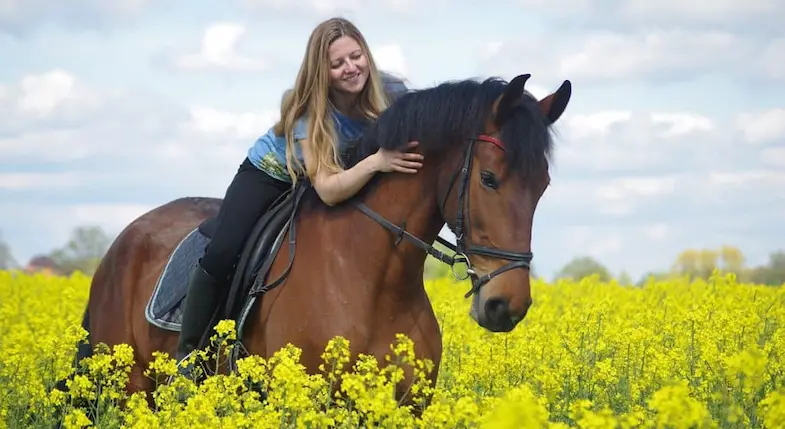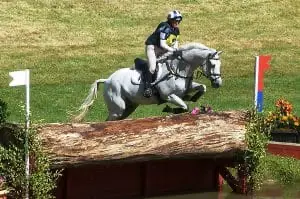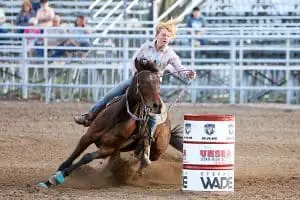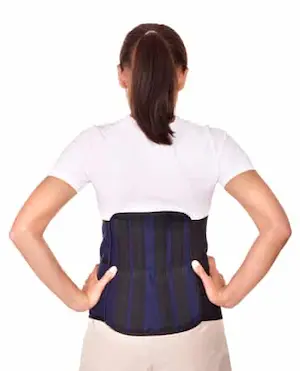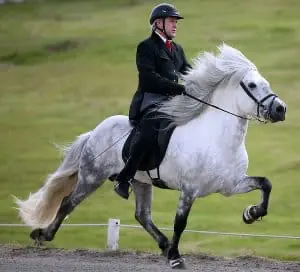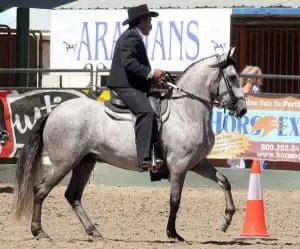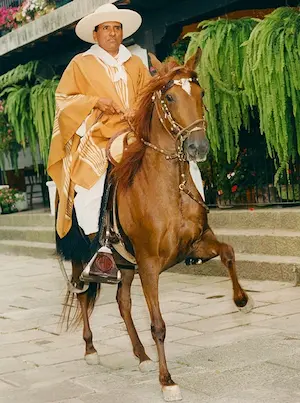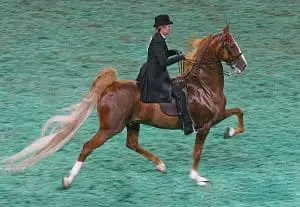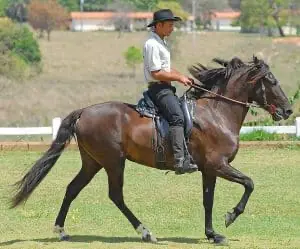With so many of us suffering from back pain at some point in our lifetime it’s a common problem that only seems to be getting worse. After all, five years ago 70% of adults experienced some sort of back pain whereas today that has increased to 80%. While back pain is a fairly broad term that covers many different forms from a pulled muscle to a prolapsed or slipped disc it can still be extremely difficult to know what the right thing to do is when it comes to horse riding. Of course, we’d all like to be riding no matter what but is that the best thing to do if you have any sort of back pain? As somebody who has suffered from several prolapsed discs (along with other back problems) and continues to ride, I thought it might be helpful to other people to write about some of the things I’ve learned about riding with back pain over the years.
Does horse riding cause back pain?
There will also be people that say horse riding causes back pain but is this correct or are they just non-riders who don’t really understand horse riding? It would be wrong to say that there are no risks involved in horse riding, after all, horses are big animals with a mind of their own, not to mention how high up you’re sitting, but that doesn’t mean to say that the risks out way to benefits nor does it say that horse riding will cause back pain. Of course, if you fall off then the risk of injury is greater but luckily, while nobody intends to fall off, there are steps you can take (such as wearing a body protector) to reduce the risk.
Anyway back to the original question, does horse riding cause back pain? As you can probably imagine this isn’t an easy question to answer and there are lots of things to take into account in order to answer the question properly and fully so I’ll go through those one at a time.
General ‘pleasure’ riding
When I talk about general or pleasure riding I’m talking about mainly walking and trotting with a bit of cantering and galloping but mainly on steady ground with no jumping at all. There is absolutely no evidence at all to suggest that sitting on a horse or walking will cause any pain in the back if you’re a fit and healthy rider. That said though, although it’s unlikely to, if you’re riding a particularly bouncy horse and aren’t rising properly then there is a chance that the effect of you rising and sitting (particularly sitting) could cause soreness and bruising to the lumbar (lower) or sacral (bottom) regions of the spine. If you don’t have any other issues with your back then this won’t last, and if you’re an inexperienced rider, it will likely improve as you progress as a rider.
Cantering on the other hand, whilst being faster, is a far less ‘bouncy’ pace than a trot so won’t do any damage to your back. Another advantage of cantering is that it’s a rhythmic pace where you move in time with the horse, almost in a rocking motion. And while galloping is faster still, again there’s no bounce, even if firmly seated in the saddle the horse’s back stays level.
Verdict: If you have a healthy back and rise in time with the horse then there’s no reason as all while pleasure riding should hurt your back or cause you any sort of pain.
Jumping
Jumping, on the other hand, is a whole different ball game than just pleasure riding. Even the best and most experienced show jumpers will experience a certain amount of impact as they ‘land’ back in the saddle but that doesn’t mean to say that jumping will cause back pain.
Every time you jump you lift yourself forward and out of the saddle and, while this is obviously a good thing, you will still need to sit back in the saddle again at some point. The best time to do this for both you and your horse is as he’s landing and moving forward with his stride. The problem with this though is that at that same moment you’re also starting to lower yourself back into the saddle which will, even if you time it correctly, inevitably result in a certain amount of impact as you both meet in the middle.
Verdict: When jumping the spine experiences a lot more impact than it would if you were pleasure riding so naturally, this is more likely to cause back pain. That said a more cushioned saddle will help to chances the risk of this while back strengthening exercises will help to improve the muscles around your spine and lower back. With strong back muscles, your spine is better able to absorb impact and therefore lowering the risk of injury while jumping.
Cross-country
As with jumping, cross-country can involve a lot of jumps but in cross-country, these jumps tend to be much harder, not in terms of how difficult or easy they are to clear but in terms of how forgiving they are if you make a mistake.
As you would expect cross-country carries the same risks that jumping does but also has its own risks on top of that. As I say the fences are much less forgiving and if your horse trips or you fall then you’re more likely to injure yourself. Of course, you’re going to try and clear every fence you can, but even with the best horse in the world this isn’t always going to happen and if you do fall then there’s every chance that you could hit the fence.
Verdict: The risk of injury is far greater than it is with jumping and while the same steps can be taken to minimize the impact felt when landing there is also the added risk of falling and hitting a fence that won’t move. While you can’t do anything to prepare your back for a fall, you can wear a back protector to reduce the severity of the fall, in fact, most organizations won’t allow you to compete unless you are wearing a back or body protector.
Reining/dressage
You might think that I’ve gone mad including reining and dressage under the same heading but although they are both very different disciplines they do share a lot of similarities with the only real difference being the speed.
If you go by what I said earlier about the effects of trotting then you’d say that dressage can cause you back pain, but the difference with ‘dressage trotting’ is that it’s a much more collected (when a horse is collected his center of gravity is underneath him and he moves in with less of a forward motion) trot where the rider experiences less bounce and sits deeper into the saddle.
With reining, on the other hand, the horse is either at a lope (or canter) or gallop and both of these paces are better for the back. The lope because the rider is moving in time with the horse and the gallop because even if the rider does sit while galloping the horse’s back is straight and there’s no bounce in the movement.
Verdict: While reining is much faster than dressage (sometimes referred to as high-speed dressage) they’re both unlikely to cause back pain and can even help to reduce the pain that you may already have.
Barrel racing
Although you’re changing your position and direction suddenly you generally sit firmly in the saddle when barrel racing which is good at lowering the risk of suffer pain. Barrel racing though is often said to be the most dangerous of all equestrian sports with people breaking all sorts of bones when they fall (which is a regular occurrence). With this in mind, it’s easy to see why barrel racing can cause back pain. It’s not the riding itself but more the sudden transition from riding to not riding, ie the falling off, that can cause back pain, especially if you and your horse fall into a barrel.
Verdict: There are no rules about any form of rider protection in barrel racing and the risk of injury is the highest out of all disciplines which makes it the activity where you’re most likely to injure yourself. I know that there’ll be a huge number of barrel racers who disagree with me on this but I’m only talking statistically.
If you already suffer from back pain
If you already have back pain then you’ll already know that you need to consider everything before just going ahead with it and horse riding is no different. As with all types of riding there is always the risk of falling but if you take this out of the equation then, instead of causing back pain or making it worse, riding can actually help.
Any physiotherapist will tell you that not only is it important to keep your back moving but that rhythmic moves can help to strengthen your back muscles which will, in turn, increase the speed with which your back can heal.
What does it mean if I suffer back pain while riding?
With 4 out of every 5 people suffering from some sort of back pain during their life it’s very common and doesn’t necessarily mean that anything is wrong so don’t worry straight away. There can be many reasons why your back is painful when you ride but the good news is that more often than not your back will get better in time.
If you’re new to horse riding or have been out of the saddle for a prolonged period of time then your muscles won’t be strong enough or developed enough to be able to support you fully. This is perfectly normal and unfortunately one of those things that people don’t tell you about before you learn to ride. If this is the case with you then don’t worry, your muscles will improve with time but you can also do simple exercises to help strengthen those muscles more quickly.
If you’re an experienced rider and have just recently taken up a new discipline that it’s more than likely that the same thing is going to apply as if you are a new rider, after all, you might not be a completely new rider but every discipline uses a different set of muscles and muscles groups and your’s won’t be used to that way of riding just yet.
Having a bad riding position can also contribute to back pain when riding, if you slouch or are too ridged then it will cause the upper (or thoracic) region of your back to ache. This is because you’re using your muscles rather than your core strength to hold that position. If you find it difficult to relax and sit upright in the saddle you can practice at home, simply sit right back into a high-backed chair and make sure your back is against the chair. Next, bring your shoulders up as high as you can and hold them for a few seconds before relaxing them. As you relax your shoulders keep your back straight, this will help you to relax while maintaining your posture. Practicing this regularly will help you to ride with a more relaxed and less slouchy posture.
In most cases, back pain will get better over time and while the amount of time it can take is different for everybody you should seek medical advice if the pain gets worse or if you start to get numbness in your leg.
Why does my back hurt after riding?
As with back pain that occurs while riding this is, in most cases, a result of weak muscles or muscles that aren’t yet used to the type of exercise you’re doing and will pass in a few days if not a few hours. If your muscles are weak then there are simple exercises that you can do to help improve those muscles. Even if your back hurts because you’re not used to riding these exercises will help.
If, on the other hand, the pain doesn’t go within a few days or gets worse then it’s important to seek medical advice, you may have only pinched the sciatic nerve (The main nerve that travels from the end of the lower back down the back of the thigh and divides just above the knee) but that’s painful enough and it’s always best to get it checked out anyway.
Does horse riding help back pain?
I know so far it sounds as if I’m saying that horse riding will hurt your back and while that may be true in some cases the opposite can also be true, in other words, horse riding can help with back pain. There’s been a lot of work carried out into the effects horse riding can have on back pain and while the jury is still out there is plenty of evidence to show that, despite what some people may say, it can actually help to improve back pain. More and more doctors and physiotherapists are encouraging riders with back pain to continue riding.
That’s not to say that if you suffer from back pain but can’t ride you should take it up, that would be a bad idea. Instead, it means that if you can ride already and know how to sit properly and move with the horse then it’s a great exercise to help ease the pain and in some cases even help to heal the back, regardless of the cause of your back pain.
Even if you’re riding a non-gaited horse the natural rhythm of the horse’s movement will help to subtly move the muscles. This motion will not only loosen tight muscles but it will also help to strengthen them.
Can I ride with a back brace?
A back brace (or lumbar brace) is designed to help hold your back steady and prevent you from moving too much, they were originally developed to help prevent people who do a lot of lifting from straining their back, but are they a good idea when horse riding?
If you don’t suffer from back pain, or the pain you have is muscle-related, then I absolutely wouldn’t use one for riding. This is because the whole idea of a back brace is to prevent you from moving your spine and thus restricting your muscles, so using one in these circumstances can actually do more harm than you. If you’re not moving your muscles then over time they will begin to weaken which will, in fact, put you more at risk of back pain. Instead, it’s better to only use a back brace if the act of moving your back exacerbates the pain.
In my opinion, it’s better to use a back or body protector instead of a back brace. A protector, as its name suggests, is designed to help reduce the risk of injury (especially if you fall) rather than to restrict your movement.
Simple exercises to help strengthen your lower back muscles
I’m sure you’ve all heard about planking and how good it is but you may not realize how good it is for strengthening your lower back muscles, reducing back pain, and even lowering the risk of suffering from pain in the future. The reason it works so well is that although you don’t move a great deal while you’re doing this exercise you do need to engage a lot of muscle to simply stay still.
As with any exercise, there are always a variety of different versions that all have their benefits but the best types of ‘plank’ for improving your back muscles are a knee plank and a cat stretch. They’re both easy to do and you will probably feel as if you’re not doing anything but if you do them correctly then they’ll be helping a lot more than you’ll realize.
To do either of those planks start by kneeling on the ground, your knees should be level with your hips and your hands should also be on the ground about the same distance apart as your shoulders. It’s also important to keep your head held up and looking straight in front of you.
If you’re doing a knee plank then you need to keep your back straight and level, holding it in that position for a few seconds then slowly stretch one leg out straight behind you. Hold that for 30 seconds before bringing that leg back and repeating with the other leg.
For a cat stretch bring your tummy muscles in towards your spine and raise your back as much as you can. Again hold that for 30 seconds before slowly lowering you back as much as you can and then holding that for 30 seconds.
Doing both of those just ten times a day won’t take long (around 20 – 30 minutes) but it will quickly help to improve your lower back muscles and strengthen your core which will also help reduce the risk of back pain.
The 8 best breeds for riding if you suffer from back pain
Gaited horses are horses that have, either due to selective breeding or due to their genetics, a natural, smooth way of traveling, as well as the usual walk, trot, and canter (and sometimes gallop) they also have at least one extra gait. There are a number of different gaits and some breeds have different names for each gait but as a rule, they always have one foot on the ground at any one time. This means that the horse’s movements are much smoother and use less energy.
Some gaited breeds, such as the Standardbred and the Hackney Horse, are primarily used for harness racing but there are still dozens that are bred for riding, the most popular ones being:
Icelandic Horse
Known for its hardiness the Icelandic Horse is the perfect gaited horse and is popular, not only for its gaits but all for its sure-footedness. On top of the walk, trot, and canter the Icelandic Horse has two lateral (A horse’s legs will move from side to side instead of diagonally as they do with the trot) gaits, the tölt, and the pace. The tölt (or tølt) gives an extremely smooth ride because there’s no suspension between strides. The horse moves a with a four-beat lateral gait which means that there is always two feet on the ground at any one time with one leg starting to rise as the other leg on the same side is starting to fall.
The pace, on the other hand, is a two-beat gait that is ridden at speed, sometimes referred to as the flying pace it’s often used in pacing races where the horses are ridden and can reach speeds of up to 30mph (48km/h). Unlike the tölt though not all Icelandic Horses are able to perform the pace.
Paso Fino
The name Paso Fino actually means smooth step and when you see them moving you’ll understand exactly how they got their name. Like the Icelandic Horse’s tölt, the Paso Fino’s three additional gaits are all four-beat lateral.
The gait that gave the breed its name is the paso fino (or classic fino) but not all horses can perform this. It’s extremely smooth but doesn’t cover much ground due to its collected nature and is mainly used for show and competition.
The paso corto, or short step, on the other hand, is more extended, in terms of speed it’s similar to the trot but unlike the trot, the rider remains seated. The paso largo, or long step, is the fastest of all of the Paso Fino’s gaits (horses can reach up to 30mph (48km/h)) and has long extended strides.
Peruvian Paso
Despite its name, the Peruvian Paso is only distantly related to the Paso Fino, having both originated from Spanish stock over 500 years ago. All Peruvian Pasos are able to perform two natural four-beat gaits, the paso llano (flat step) and the sobreandando, both of which can feature the termino. This is a unique characteristic of the Peruvian Paso where the front legs graceful move outward as the horse moves forward, rather like a swimmer’s arms.
Both of the Peruvian Paso’s gaits can be performed at different speeds although the paso llano is generally slower (more like a trot) than the sobreandando which is more akin to the canter.
Tennessee Walker
Originally bred as a comfortable mount for plantation owners, the Tennessee Walker (or Tennessee Walking Horse) has three unique gaits as well as a different canter to most other breeds.
The slowest gait is the trail pleasure walk which is sometimes referred to as a dog walk. It’s a very relaxed four-beat gait but is normally reserved for the show ring.
The flat walk is smoother and slightly faster than a ‘normal’ walk because the horse is effectively ‘sliding’ his hind foot into the same area the front foot has just left. This results in very little movement being felt by the rider.
The Tennessee Walker is famed for its running walk gait which is similar in timing to the flat walk but considerably faster. The running walk has an overstep (where the hind foot steps over the imprint left by the front foot) of between 6 and 18 inches. This overstep gives the rider a feeling of gliding or floating, it also makes this gait extremely smooth. Most horses will also nod their head in time with the running walk.
A Tennessee Walker’s canter is similar to that of other breeds except for the fact that it’s much more relaxed and has a diagonal movement, rather like a trot.
American Saddlebred
Referred to for many years as the Horse America Made, the American Saddlebred is an immensely popular breed across the globe due to its friendly nature and comfortable ride. As well as the ‘normal’ walk, trot and canter, all American Saddlebreds have an extra two gaits, the slow walk, and the rack.
Despite its name the slow walk, which is a four-beat lateral, isn’t always performed at a walking pace. It’s sometimes called the running walk or stepping pace and is more akin to a fast trot in terms of speed.
The rack, on the other hand, which is also a four-beat lateral gait, is regularly performed with speed, especially in the show ring. The rack is very distinctive due to its high-step action where the horse raises his knee level with (and sometimes above) his shoulder.
Missouri Fox Trotter
Like many other gaited horses the Missouri Fox Trotter (or Missouri Fox Trotting Horse as it’s also known) is able to perform a variety of different gaits, although there are three that every Missouri Fox Trotter is able to perform, the flat walk, foxtrot, and canter.
Both the flat walk and the canter are similar to the same gaits of the Tennessee Walker but the foxtrot is totally unique to this breed. Like the trot it’s a diagonal gait but, unlike the trot, the legs don’t move in a uniformed diagonal. The front leg will move a fraction of a second before the rear leg does which creates a smooth, rhythmic, almost rocking, pace that offers the rider a very comfortable ride. If a horse is ‘fox trotting’ properly then he’ll always have two feet on the ground at any one time. Missouri Fox Trotters, like the Tennessee Walker, also nod their head as they move.
Mangalarga Marchador
Originating from Brazil the Mangalarga Marchador has two gaits known as marcha (which is Portuguese for march), the batida which is similar to the Missouri Fox Trotter in that the horse moves diagonally, and the marcha picada which is similar to the Icelandic Horse’s pace.
The marcha batida has a diagonal gait with a slight overstep and can transition into a canter. The marcha picada, from which the horse can also move into a canter, has a four-beat lateral movement and is smoother than the batida due to its collected nature.
Walkaloosa
A relatively new breed that is growing in popularity, the Walkaloosa is a gaited horse with verifiable Appaloosa pedigree. Walkaloosas perform a unique gait called the Indian Shuffle which is a four-beat lateral pace where the horse moves each foot separately from the other. Sometimes called an Appaloosa Shuffle, it’s known for its rolling motion where the back absorbs the horse’s movement, resulting in a smooth ride. As a side note, the breed registry for the Walkaloosa was co-formed by the same Claude Thompson who established the Appaloosa Horse Club.
Take home message
I know it’s a cliché to say that you should listen to your body but it’s even more important with you’re dealing with back pain. Only you know how bad the pain is and how riding feels for you, if you find that riding eases the pain continue with it, if you find it makes it worse then dismount. Everybody is different and I can only speak from my experience but I’ve only even stopped riding because of my back pain once. I didn’t realize it at the time but I had a prolapsed disc and had lost all of the strength in my right leg. Riding helped with the pain but I realized that, due to the loss of strength in my leg, I was sitting off to one side. This unbalanced me which made the horse very nervous so I made the sad decision to not ride until after my back was better. It was difficult to do but I still believe that was the right thing to do.
I hope you found this article helpful. If you did I’d be grateful if you could share it please as it would really help me.
Recommended products
Over the years I have tried hundreds of different horsey products, from various blankets and halters to different treats. Some I’ve loved, others I’ve hated but I thought I’d share with you my top all-time favorite products, the ones I never leave the yard without. I’ve included links to the products (which are in no particular order) that I really think are great.
- Horse Knots by Reference Ready – If you’re like me and enjoy pocket reference guides then you’ll love this knot tying guide. These handy cards can easily fit in your pocket or attach to the saddle for quick reference. They’re waterproof, durable and are color coded to make them easy to follow.
- Mane ’n Tail Detangler – Even if you never show your horse you’ll need to detangle his tail from time to time (and possibly his mane too) which is always a challenging chore! I’ve found that if I run a little bit of detangler through my horse’s tails every few days it stops them from getting matted up and makes combing them easy, even if they’re coated in mud. I don’t know if I should admit to this or not but it also works wonders on my hair.
- TAKEKIT Pro clippers – Over the years I’ve tried a lot of different clippers and while some were obviously better than others I found these to be by far the best. They are heavier than a lot of other clippers but for me, that’s a good thing, it makes them feel more sturdy and hardwearing. On top of that they have a range of speeds so are just as good for clipping your horse’s back as they are his face. I also like the fact that they come in a handy carry case but that’s not for everybody. The company that makes them is super good and incredibly helpful too, a real bonus these days. The only thing I wasn’t keen on was the fact that it doesn’t come with any oil, but that’s not a major problem as it’s not difficult to buy lubricant.
- Shire’s ball feeder – There are so many boredom buster toys out there but I like to use these every day, regardless of whether or not my horses are bored. I find that it helps to encourage my horses to problem solve by rewarding them with treats (or pieces of fruit) but it also mimics their natural grazing behavior which helps to keep them calm and de-stressed.
- Horse safe mirror – This is a strange one that many people are surprised about but I like to put horse safe mirrors in the trailers as well as in the quarantine stalls. It helps to prevent the feeling of isolation by giving the impression of other horses being around. Being herd animals horses can get extremely stressed when they feel that they’re on their own but with these stick-on mirrors, they believe that at least one other horse is with them.
- Rectal thermometer – I know this isn’t glamourous at all but it’s vital for your horse’s well-being to be able to check their temperature and a rectal thermometer is the easiest way of doing this which is why I’ve added it to the list.
Shopping lists
I’ve also put together a few shopping lists of essential items that I’ve found helpful over the years. I’ve broken the lists down into different categories rather than put everything in one massive list 😉

